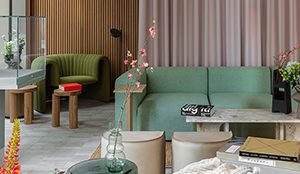INTERIOR TREND: Home Hospitality
As the trend of concentrating the home continues, hospitality spaces reflect tastes for welcoming environments that offer comfort, protection and familiarity.
The pandemic-accelerated home trend continues to influence consumer expectations. A new wave of hospitality, workplace and wellness spaces share a sense of warmth and familiarity, recognizing that a homey feel will resonate with consumers.
Designers are elevating an aesthetic code that celebrates the ordinary and familiar to convey a message of comfort and relaxation.
- the cocoon urban: urban hotels are reducing the social hubbub and introducing domestic touches
- Patina creative: the eclecticism of the home is mimicked through a mix of old and new to celebrate history and elevate history.
- vintage Dark: a sophisticated take on the home aesthetic relies on muted colors, low lighting, and references to heritage.
- Rustic modern: a stripped-down interpretation of farmhouse appeal for travelers seeking contemplative spaces that blend the rustic with the practical.
- The environment anti-work: soft work environments create a sense of continuity between home and office
Consumers are looking for something that feels real and familiar in an increasingly digitized world, fueling the trend for home interiors that are tactile and warm, full of meaning and character. According to Euro monitor's 2022 Lifestyles Survey, “real-world experiences” are the top priority among 80 %s of consumers, while online experience was the least important with 50 %s.
- With people valuing their homes more than ever, it celebrates the simplicity of the domestic space by introducing design elements consumers will find familiar, such as wood-burning stoves, hearths, kitchen islands, wood cabinetry and soft furnishings.
- Create quiet corners, reading corners and contemplative spaces. Despite the return of socialization, the design of spaces that allow users to be alone will continue to be important. Consider how garden architecture can be used to protect guests from each other, as well as from the outside environment in hotels.
- It brings the eclecticism of home into the hospitality space through antiques, collectibles, artifacts and flea market finds along with fresh, locally sourced design accents. Bring a sense of history and tell a local story.
- Take note of how designers use rich traditional palettes, dark florals, vintage prints and artwork, and low lighting to create a sophisticated and nostalgic atmosphere.


